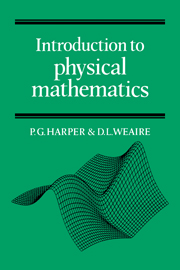Book contents
- Frontmatter
- Contents
- Preface
- Some notes on notation
- 1 Introduction
- 2 Errors
- 3 Cartesian coordinates
- 4 Vectors
- 5 The scalar product
- 6 The vector product and rotation
- 7 Matrices in physics
- 8 The transformation of matrices
- 9 The matrix eigenvalue equation
- 10 Exponential and logarithm functions
- 11 Sine and cosine functions
- 12 Graph plotting and curve sketching
- 13 Differentiation
- 14 Approximations
- 15 Power series and Taylor's expansion
- 16 Partial differentiation
- 17 Integration
- 18 The differential equation
- 19 Solving first-order differential equations
- 20 Second-order differential equations
- 21 Solving second-order differential equations
- 22 The complex exponential
- 23 The circuit equation
- 24 Harmonics and Fourier series
- 25 The diffusion equation
- 26 Waves
- 27 The rate of change of a vector
- 28 The scalar field and gradient operator
- 29 The vector field
- 30 Line integration
- 31 The potential field
- 32 Surface and volume integration
- 33 Flux and divergence
- 34 Circulation and the curl
- 35 Conclusion
- 36 Miscellaneous exercises
- Index
13 - Differentiation
Published online by Cambridge University Press: 20 October 2009
- Frontmatter
- Contents
- Preface
- Some notes on notation
- 1 Introduction
- 2 Errors
- 3 Cartesian coordinates
- 4 Vectors
- 5 The scalar product
- 6 The vector product and rotation
- 7 Matrices in physics
- 8 The transformation of matrices
- 9 The matrix eigenvalue equation
- 10 Exponential and logarithm functions
- 11 Sine and cosine functions
- 12 Graph plotting and curve sketching
- 13 Differentiation
- 14 Approximations
- 15 Power series and Taylor's expansion
- 16 Partial differentiation
- 17 Integration
- 18 The differential equation
- 19 Solving first-order differential equations
- 20 Second-order differential equations
- 21 Solving second-order differential equations
- 22 The complex exponential
- 23 The circuit equation
- 24 Harmonics and Fourier series
- 25 The diffusion equation
- 26 Waves
- 27 The rate of change of a vector
- 28 The scalar field and gradient operator
- 29 The vector field
- 30 Line integration
- 31 The potential field
- 32 Surface and volume integration
- 33 Flux and divergence
- 34 Circulation and the curl
- 35 Conclusion
- 36 Miscellaneous exercises
- Index
Summary
Wherever there is a function, theory finds a star role for its ‘rate of change’. Indeed, relations (differential equations) which involve this quantity are the simplest means the human mind has found to express the principles of such sciences as dynamics, electromagnetism, thermodynamics, and even the statistical laws of chance.
Such an important and practical notion can hardly be abstruse. Although its inventors Newton and Leibniz were innovators of genius, common mortals can easily pick up its use. First of all comes the functional relation: speed versus time; heating-oil consumption versus outside temperature (a steepening curve!); mean river speed versus river width. Sometimes ‘continuous’ is interpreted loosely, as in the frequency of road repairs versus the mean traffic flow, but the idea remains the same. One variable is selected as ‘independent’ (time, perhaps), and the other as ‘dependent’. The choice is not always compelling – is traffic flow controlled by road repairs or are repairs caused by traffic? The mathematician, passionate for abstraction, denotes the independent variable by plain x, the dependent variable by y and expresses the relation as y = f(x). Actually, the mathematician probably has in mind an algebraic relation of y to x, and might object that the above examples do not constitute ‘differentiable’ relationships. With a graph or tabulation of y = f(x) there is usually no difficulty in numerically estimating the differentiated function. This is just the local slope plotted (or tabulated) against x.
- Type
- Chapter
- Information
- Introduction to Physical Mathematics , pp. 87 - 93Publisher: Cambridge University PressPrint publication year: 1985



